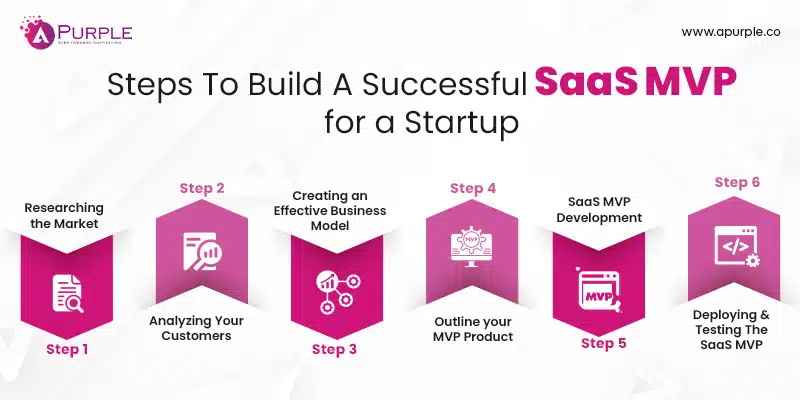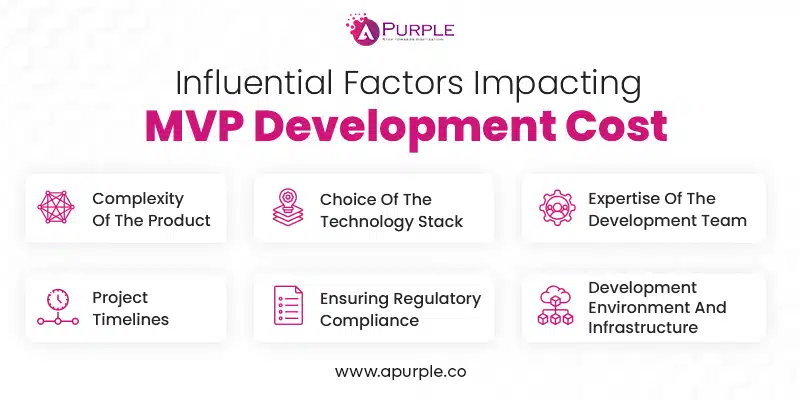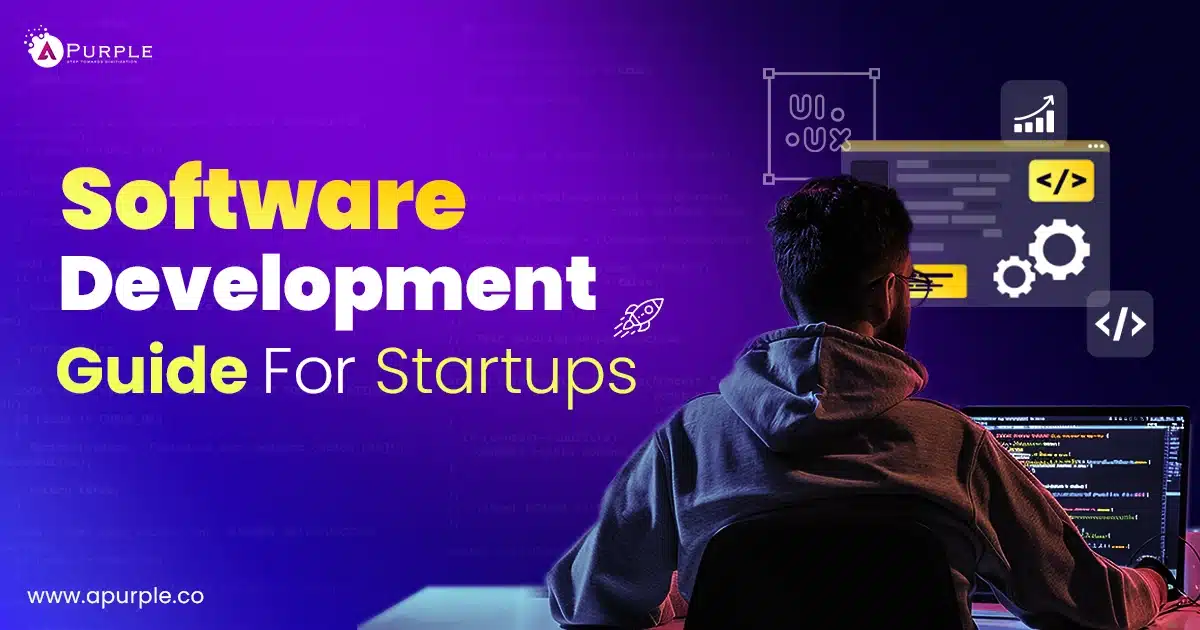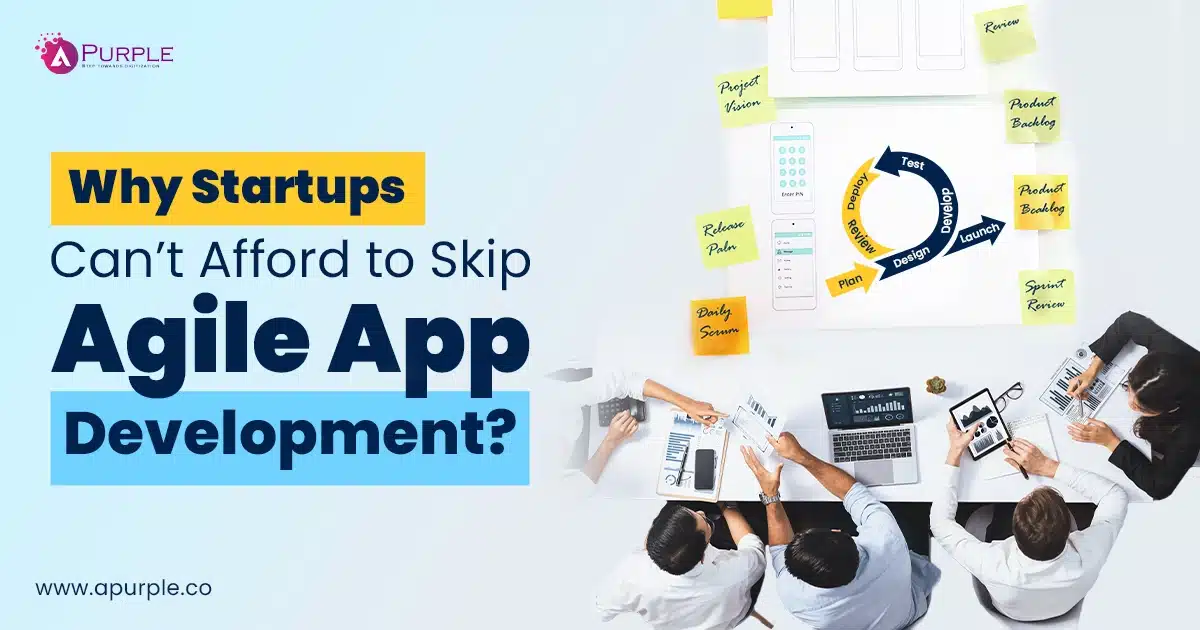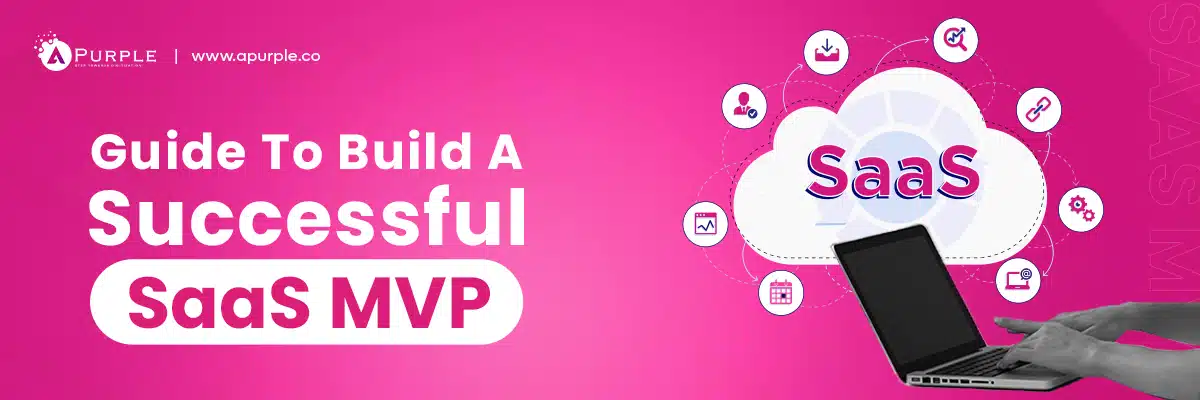
When building a SaaS (software-as-a-service) product for your startup, you must consider challenges like limited resources, time pressure, and uncertainty. You also need to manage technical complexities, scale operations, and ensure a focus on core business values. This can be overwhelming for business owners, making it confusing for them to identify where to start.
This is where SaaS MVP (Minimum Viable Product) solutions can help. Most startups prefer SaaS MVP development to test ideas with limited resources and gather user feedback to improve the product. It’s an affordable and risk-free way for them to prove and validate their products. In fact, according to a report, the SaaS industry revenue will reach $819.23 billion in 2030, leading many startups to enter the SaaS niche. Here is an image of SaaS revenue to get an idea of the profit for the business:
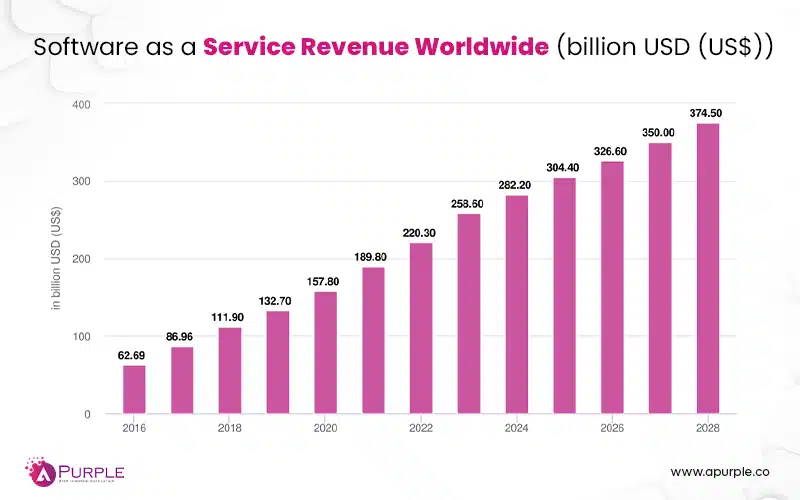
However, due to technical and strategic limitations, most SaaS startups need help effectively building MVPs. This impacts several aspects, including a product’s feasibility report, testing, and whether the SaaS software is right for the targeted market.
This article will help you understand how to build a robust SaaS MVP, how much a SaaS MVP development costs, and what mistakes startups can avoid. Let’s start with the SaaS MVP basics first.
What Is MVP In SaaS?
An MVP in SaaS is a basic version of your solution with essential features. It solves a specific problem for users. Startups usually test their business ideas fast and affordably using an MVP. It is possible because of the low production cost, and It provides feedback for future development. The MVP development for SaaS helps in idea validation and initial relationship building with customers. This also allows stakeholders like investors and customers to gauge the value of SaaS products.
SaaS MVP development can offer many other benefits as well. Let’s take a look at them.
SaaS MVP Development Benefits
SaaS MVPs target user needs and problems without requiring large investments in building a full-fledged product. This approach involves gathering feedback, validating products, and planning future development. A SaaS MVP typically excludes advanced or non-essential features, focusing instead on the key elements that provide value to customers.
Here are some of the MVP benefits for SaaS startups-
- Reduced Risk: Developing a SaaS MVP for startups helps reduce risks by testing ideas and determining whether there is market demand before fully launching the product.
- Faster Time-To-Market: Concentrating on just the essential features can speed up the development process and take advantage of market opportunities sooner.
- Competitive Advantage: Releasing a SaaS MVP early can help grab a market share before the competitors do.
- Cost Efficiency: Creating a SaaS MVP is usually much cheaper than building a complete product with all the bells and whistles.
- Easier Funding: Showcasing the main features and benefits of your SaaS MVP can help you attract investors.
- More time to refine: Startups can collect feedback from early users and focus on improving the product based on how people use it.
While SaaS MVP offers key benefits for developing and deploying software products, its implementation is equally important. Let’s go through the building process of SaaS MVP.
How To Build A SaaS MVP for a Startup?
From researching the need for SaaS MVP in a market to developing and testing it, here are key steps:
Step 1. Researching the Market
Having an idea for a SaaS product is one thing, but implementing it and taking your MVP to market is another. Here are some pointers you need to go through:
- There are no similar products in the market to gain a monopoly in the market.
- Analyze the competition and the products.
- Solutions provided by competitors.
- Are current solutions enough?
Step 2. Analyzing Your Customers
Understanding your customers and what they want can completely change the dynamics of your company. Since you are in the initial phase of building an MVP for SaaS, you can easily mold it to meet your customers’ needs and demands.
- Target the type of consumer through the solution you offer.
- Create a customer persona based on your survey and analysis.
- Laws and regulations apply to customer locations and industries (HIPAA, GDPR, PCI DSS, APPI, PSD2).
This must detail the average customer’s age, gender, demographics, social behavior, social status, financial status, etc. You can also use various SaaS MVP examples while creating your customer persona.
Step 3. Creating an Effective Business Model
You can choose from several different business models and plans, such as a subscription-based model, a lifetime membership plan, etc.
Here are some examples of Effective Business Models:
- Free Model: This model comes with basic free features with paid premium features.
- Tiered pricing model: Different prices according to the different criteria.
- Usage-based pricing model: Price depends on the data and usage consumption metrics
- Variable pricing model: Price based on individual clients.
- Flat rate model: All features on a monthly subscription.
- User-based pricing model: The customer is charged based on the number of users.
Selecting an effective business model can contribute to your business’s success on a large scale.
Step 4. Outline your SaaS MVP Product
Outlining your MVP product for SaaS is one major step in helping you stand out. First, analyze all the core features to determine what to include in your SaaS MVP.
- Essential features for your SaaS product
- Does your target audience want it?
- Does it fulfill the user requirement?
- What are the impacts on revenue?
Step 5. SaaS MVP Development And Promotion
To start the development, you need to analyze and document all project requirements.
| Software Specs |
What It Does: Outline the main functions and performance expectations of the SaaS MVP.
Tech Stack: List the programming languages, frameworks, APIs, and systems that will be used. |
| Design Specs |
Key Features: Highlight the important functionalities and user interface (UI) elements.
How It Works: Describe how to meet requirements during coding. |
| Cloud Assessment |
Best Setup: Evaluate the best cloud architecture and infrastructure for your app.
Infrastructure: Implementation architecture based on microservices to enhance flexibility and support without service disruptions. |
| Security Check |
Risk Management: Identify security risks and how to prevent them.
Compliance: Makes sure to follow important rules like GDPR or HIPAA, It is based on how sensitive the data is. |
| Post-Launch Docs |
Support Materials: Documentation to assist maintenance and support teams after the app launch.
Technical Documentation: Clear system architecture diagrams, API guides, and version information for the maintenance teams. |
After completing the outline step and identifying core features, you can begin developing your SaaS MVP.
- Avoid excessive focus on perfecting functionality.
- Don’t overwhelm your MVP for SaaS by introducing new features. Focus on core features instead.
- Launching the SaaS MVP ahead of competitors is crucial.
- Aim to deliver a product through a brief development cycle and release it to the market sooner.
Prior to the deployment, make sure you promote the SaaS MVP across the channel. It will help your product get early users, which is crucial for gathering and analyzing feedback.
Float a video or build a landing page that informs all the stakeholders, including investors, customers, and influencers, about your SaaS MVP.
Step 6. Deploying And Testing The SaaS MVP
Deploy the MVP for SaaS across platforms and collect feedback to evaluate your product. Analyzing customer feedback will highlight usage problems and determine whether you must address functionality concerns.
Some of the popular methods of gathering feedback are:
- Usability tests
- Email contact forms
- Social media
- Exploratory customer interviews
- Customer surveys
- Analytic metrics
You should create a tight feedback loop to learn:
- If your SaaS MVP creates enough buzz and demand, it’s time to think about full-scale development.
- Discover the features that clients like and identify dislikes.
- Ensure your business model aligns with your solutions.
- Evaluate whether your pricing hits the mark or not.
Once you analyze the feedback, integrate it with each iteration. Create and test multiple iterations before you launch the final product.
This can also help improve development speeds. In a competitive market, it is essential to time the product right. Here are the top ways to reduce the time needed for the SaaS MVP development process.
6 Ways To Speed Up SaaS MVP Development
Let’s go through some methods to speed up the building SaaS MVP process:
1. BaaS
Backend-as-a-service (BaaS) platforms play a crucial role in speeding up the development of a SaaS MVP. They simplify and automate backend processes, allowing you to concentrate on front-end development.
BaaS providers facilitate integrating third-party services into your app through APIs or background automation, including tasks like database management, authentication, system updates, and notifications. This accelerates the SaaS MVP development cycle, enabling startups to launch their products more swiftly.
2. Low-Code Platforms
Low-code platforms are software development environments designed to accelerate the development process. They do not require advanced expertise and allow users to navigate via graphical interfaces, reusable modules, pre-built code, and templates. These tools need minimal coding, enabling quick deployment of your SaaS MVP and significantly enhancing development speed.
Low-code environments offer benefits like shorter sprints and manageable experiments. However, low-code platforms have an issue. They do not offer customization options for SaaS MVP development. So, if you want to add customizations to the SaaS MVP, these platforms could be better.
3. Popular Tech Stack
The necessary tech stack depends on the complexity of the project, but it’s preferred to use the following programming languages and frameworks for better support:
- JavaScript (JS) is perfect for frontend development because of its wide use of it.
- Python is a dynamic programming language and works with many high-level frameworks.
- Node.js runtime for simultaneous web development and fast client-side rendering
- React Native framework is ideal for building MVP mobile apps for SaaS to multiple operating systems.
4. Follow Agile methodology
Agile methodology divides the project into small milestones and manageable sprints, enabling the team to deliver incremental updates, gather user feedback, and rapidly enhance products. Through this iterative approach, the product is refined to align with user requirements. With each spring, startups can improve the SaaS MVP and gradually convert it into a full-fledged product.
5. Open-Source Tools
Open-source toolkits such as Bootstrap and GitLab are excellent for accelerating development. However, relying on open-source tools carries risks, such as potential bugs and insufficient documentation. That said, these tools can significantly reduce the time required in the early phases of a project. Consider using free databases like MySQL since your SaaS is unlikely to have millions of users at its outset.
6. IT Outsourcing
Assign the project to an external SaaS MVP development company. SaaS outsourcing allows you to get a qualified professional team, which reduces the time needed to hire and train an internal team. It’s also helpful for your startup as you can focus on other aspects if you consider hiring an outsourcing company.
Companies with a cross-functional team of business analysts, developers, designers, QA engineers, etc. It will accelerate decision-making, streamline communication, and significantly speed up SaaS MVP development.
While using the above approaches can help reduce the time spent developing a SaaS MVP app, here are some key examples of how industry leaders have done it successfully.
These examples offer key strategies for speeding up SaaS MVP development. However, one aspect needs to be considered before implementing these strategies: “SaaS MVP development cost.”
How Much Does It Cost to Build an SaaS MVP?
Before starting with an SaaS MVP, most entrepreneurs often seek financial aid and support from investors. If you are planning to get investors on board, you must consider the valuation of your future company. However, if you plan to pull in the money yourself, you must know how to evaluate the cost of the SaaS MVP yourself.
A basic SaaS MVP can cost you around $18,000 but can even go up to $1,50,000 depending on the complexity of the software, the design, the framework, etc. It can also vary if you choose to go ahead with a software development company.
Now, let’s dive into the details and break down each aspect further.
SaaS MVP Cost Breakdown
Cost Analysis based on Team Location
Location plays a vital role in SaaS MVP Development, as some of the country’s services are very high.
| Location | Cost |
|---|---|
| USA | $90,000 – $200,000+ |
| Ukraine | $25,000 – $170,000+ |
| Mexico | $50,000 – $190,000+ |
| India | $18,000 – $150,000+ |
Cost Analysis based on Complexity
The complexity changes the complete development process and costs according to additional expenses.
| Complexity | Cost |
|---|---|
| Basic | $18,000 – $40,000+ |
| Intermediate | $30,000 – $65,000+ |
| Highly Complex | $70,000 – $200,000+ |
Cost Analysis based on Type
Various types of SaaS MVPs can change the complete scenario in terms of cost.
| Type | Cost |
|---|---|
| CRM | $18,000 – $65,000+ |
| Accounting software | $40,000 – $80,000+ |
| Marketing and sales software | $30,000 – $75,000+ |
| ERP | $70,000 – $200,000+ |
Factors That Impact The Cost Of Developing SaaS MVP
1. Complexity of the Product
One primary factor influencing an SaaS MVP’s cost is its complexity: the more intricate the features and functionalities, the higher the development costs. Simple MVPs for SaaS with basic features will naturally be cheaper than those that demand intricate coding, advanced algorithms, or integration with cutting-edge technologies. Businesses must carefully evaluate product requirements and prioritize features to balance functionality and budget constraints.
2. Choice of the Technology Stack
The choice of technology stack is another key determinant of development cost. Different technologies have varying development and maintenance costs. Open-source technologies might reduce initial expenses, but businesses should consider long-term maintenance and scalability. Proprietary solutions may offer more robust features but could incur higher licensing fees. Striking the right balance between cost and technology suitability is crucial during SaaS MVP development.
3. Expertise of the Development Team
The expertise of the development team also significantly influences the cost. Hiring skilled professionals with experience in the specific technology stack, industry, and project complexity is vital. While experienced developers may demand higher salaries, their proficiency can expedite development, ultimately affecting the overall cost. Investing in a competent team ensures a smoother development journey and can save costs in the long run by preventing errors and delays.
4. Project Timelines
Project timelines are another factor to consider when estimating the cost of developing an SaaS MVP. Rushed timelines often lead to increased expenses due to overtime pay and potential errors that may arise from the pressure to meet tight deadlines. A well-planned development schedule allows for more efficient use of resources, reducing the likelihood of unexpected costs.
5. Ensuring Regulatory Compliance
External factors like regulatory compliance and industry standards can also impact development costs. Ensuring the product complies with legal requirements and meets industry standards may involve additional expenses for specialized consultations or compliance-related features. However, overlooking these aspects can result in costly legal issues and reputational damage.
6. Development Environment and Infrastructure
The development environment and infrastructure contribute to costs. Cloud-based solutions offer scalability and flexibility but may lead to ongoing operational expenses. On the other hand, on-premises solutions require a higher initial investment in hardware and infrastructure but may prove cost-effective in the long term. Businesses should carefully evaluate the pros and cons of each option based on their specific needs and future growth projections.
Apart from the above factors, startups need to consider overhead expenses. These costs occur due to mistakes and errors committed during the project execution.
Top Mistakes to Avoid When Creating a SaaS MVP
Startups can make mistakes during SaaS development. However, if they are not resolved quickly, these mistakes can lead to catastrophic impact.
Here are the top mistakes to avoid for your SaaS MVP project.
1. Too many features
Lack of clarity about features and target users can lead to development delays. It also led to excessive spending on the product through the development of features that may not directly impact possible business outcomes.
You can follow the MoSCoW prioritization method, which helps prioritize features according to their significance.
The categories are:
- Must-Have: It includes the features without which the launch is pointless, such as critical features, compliance, regulatory requirements, or safety measures.
- Should-Have: It includes features that are of high priority. You can add them before the launch.
- Could-Have: These are optional features and are not necessary to add.
- Won’t-Have: Unnecessary features or features you’ll add in the later development stage of your product.
2. Undefined goals
Undefined goals also result in scope creep. Since the plans are ambiguous, there’s a risk of adding unnecessary features to the SaaS MVP. When goals are unclear, it’s hard for team members to figure out which essential features are. This can lead to unclear priorities and higher costs in building the SaaS MVP.
Additionally, time, budget, and manpower might be wasted on features that don’t connect with the target audience.
Unclear goals can also confuse team members and slow down the launch. They increase the chance of overengineering the product, complicate testing, and make it easier to make changes quickly.
3. Poor project management
Poor project management can lead to team members feeling disconnected. If roles and responsibilities are not clearly defined, teams need more help from their managers, and motivation starts to slip away.
If tasks aren’t appropriately assigned, some tasks may be repeated while others might be missed.
Poor project management may prevent startups from facing greater challenges, such as inefficient workflows, longer development cycles, and difficulties adapting to market changes. This can also negatively impact the deployment process.
However, here are some solutions to Improve Project Management:
- Use agile app development to manage SaaS MVP.
- Define roles clearly and make sure everyone knows their specific tasks and responsibilities.
- Set measurable goals by outlining what you want to achieve with the SaaS MVP.
- Use project management Tools like Trello, Jira, or Asana. It will help to track tasks and manage workloads.
- Hold regular standups and reviews to keep everyone updated and tackle any blockers.
- Automate repetitive processes using CI/CD (Continuous Integration/Continuous Deployment) tools like Jenkins or GitHub.
4. Lack of user feedback
A lack of proper user feedback than anticipated can hamper your SaaS MVP projects. User insights are crucial for shaping product design to meet user requirements.
Lacking user feedback can lead to a misalignment in product-market fit for startups. With this feedback, startup owners can make the right decisions. Furthermore, identifying which features should take priority without user input and market research becomes challenging.
That’s why it’s necessary to use feedback to improve the product. You can leverage user feedback to:
- Optimize product functionality
- Improve customer retentiveness
- Improve pain points
- Validation of product-market fit
- Address user requirements
5. Lack of prototyping
Teams often assume that an MVP can only be created with working prototypes. However, prototyping is essential to demonstrating the viability of a SaaS MVP before it launches in the market.
Failing to invest time in creating a prototype can harm your brand’s reputation if the initial build encounters issues.
Read also: Key differences in POC vs Prototype vs MVP for tech entrepreneurs.
6. Waiting too long or “until it’s perfect”
Some startups get caught up in the pursuit of perfection. While fixing every possible issue before launching a new product might seem smart, overdoing it can backfire.
Believing you can create a flawless product on your first attempt often leads to disappointment without honest customer feedback.
Avoiding these mistakes may seem to be tedious, and if an entrepreneur is from a non-tech background, it becomes extremely difficult. This is where an expert like aPurplecan help by providing SaaS MVP development solutions.
Top SaaS MVP Examples
While creating an SaaS MVP, you must use examples that can be valuable case studies. For instance, your top two SaaS MVP examples are IBM and Oracle. You must use their case studies and learn about their mistakes and failures.
1. IBM
IBM’s journey into the SaaS space shows its ability to adapt and innovate. This transition showcases how even established giants can successfully apply the MVP.
- Strategic Expansion
Instead of releasing a comprehensive solution, IBM opted for a modular strategy. This method allows businesses to adopt specific components as required, aligning with the MVP principles.
- A Model of Adaptability
IBM’s evolution into SaaS is a powerful example of adaptability. Starting with an MVP, the strategic shift to cloud services shows that even industry leaders can benefit from iterative development.
In summary, IBM’s journey into SaaS represents the importance of being flexible and responsive to market demands.
2. Oracle Corporation
Oracle has evolved from a database management pioneer to a SaaS company. This transition shows its commitment and ability to adapt to the digital age.
- Modular MVP Approach
Oracle developed targeted modules that address specific enterprise requirements. This helps businesses adopt only what they need while enhancing their offerings based on user feedback.
- Building Comprehensive Solutions
By releasing focused modules first, Oracle tests ideas, gathers user insights, and refines each component before integrating them into a broader suite of applications. This method strengthens the overall product and ensures that new features fit seamlessly into systems.
- A Model for Success
Oracle’s strategy is the necessity of a modular design, where every developed part becomes a comprehensive solution. Oracle’s journey focuses on adaptability and modular platforms.
How Does aPurple Help You Build Your SaaS MVP Solution?
We hope this article has offered profound insights into why you should consider SaaS MVP solutions.
If you’re looking for someone to assist you, especially with entertainment, car rental, healthcare, eCommerce, and logistics industries, aPurple is at your service.
With more than five years of experience and 300+ successful projects delivered, our experts are adept at developing SaaS MVPs. Get customized SaaS MVP consulting services from our experts.
We design solutions that meet your business-specific requirements and guarantee improved business. Get in touch with one of the top SaaS MVP companies to build custom SaaS MVP solutions.
Frequently Asked Questions
Steps to build a successful Saas MVP:
- Researching the Market
- Analyzing Your Customers
- Creating an Effective Business Model
- Outline your MVP Product

